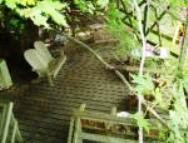The bur oaks of Shady Oaks are over 200 years old and through history have welcomed travelers in need of rest.
Long before the Lincoln Highway came to central Iowa, the community Of Rock Valley developed in the area where the Brush Creek merged with Timber Creek to flow on to the river. Before Rock Valley, the Native American Tribes of the area knew it for hunting, fishing and resting. Today the bur oaks of Shady Oaks serve the same purpose -- a rest stop for weary travelers.
First came the grist mill, followed by the Methodist Mission, the community evolved and the school was built. The grove of bur oaks on the stage coach run between Marengo and Fort Dodge was the center of activity for the Rock Valley community -- it was the place where travelers rested for the night, the area where the citizens waited while their grain was milled. It was the center for church and school activities. The bur oak grove would eventually be the first campground and cabin camp west of he Mississippi River and continues today serving those traveling the Lincoln Highway.
In 1851 Henry Anson took advanage of the government land acquired through the Treaty of 1842 with the Sac and Fox tribes. He would build a town between Linn Creek and the Iowa River. With the help of Johnny Green, a Potawatomie Chief, the land was settled, the railroad came and the town flourished. Marshalltown, according to the Lincoln Highway Association's 1916 "Official Road Guide to the Lincoln Highway," was 1,207 miles from New York City and 2,124 miles from San Francisco. Shady Oaks is 3 miles east of Marshalltown. The trip from New York City to San Francisco was "something of a sporting proposition," and would take 20-30 days averaging 18 miles per hour.
The guide suggested motorists buy gasoline and supplies at every opportunity, not knowing where the next food, fuel and rest would be. They were advised to wade through water before fording it with their vehicle and to avoid drinking alkali water which "can cause serious cramps." The guide advised motorists travel with a full set of camping gear and select sites early. Equipment recommended included chains, shovel, axe, jacks, spare tires and inner tubes, a set of tools for vehicle repair. The motorist could expect the trip to cost no more than $5 per person per day.
In 1940, NBC Radio introduced a Saturday morning dramatic show, "Lincoln Highway." Sponsored by Shinola Shoe Polish, it featured stories of life along he highway. It left the air in 1942 - but not before bringing the stories of the Lincoln Highway into homes all over America.
There were few amenities for those traveling the Lincoln Highway in the early years. A few hot cramped hotels in the cities or a camping site along the road. The grove of bur oaks at Shady Oaks was one of those spots. Eventually a gas station and diner would be added.
In 1925 the section of the Lincoln Highway in front of Shady Oaks was paved. By 1941 Shady Oaks Cabin Camp played host to nearly 6,000 travelers. Eighteen cabins, a meeting room building, a lodge, beautiful landscaping and a rock garden greeted visitors. Today one of the cabins is being restored, most are gone. The log meeting building and the lodge remain serving different purposes. Transformed into an RV park, it is Iowa's oldest privately owned campground and has been in continuous operation for over 80 years. In 1996 the stand of bur oaks was recognized as famous and historical trees in Iowa.
 Original cabins from the Shady Oaks Cabin Camp. Visit http://www.bigtreehouse.net/ to see more pictures of the early campground and some of the renovation work being done on one of the original cabins.
Original cabins from the Shady Oaks Cabin Camp. Visit http://www.bigtreehouse.net/ to see more pictures of the early campground and some of the renovation work being done on one of the original cabins.
Nestled in a tree at Shady Oaks is the Big Treehouse. For Mick Jurgensen, the treehouse is a hobby. For the rest of us, it is an amazing project and story. Started in 1983, this 12-level structure is more than 55 feet high with more than 7,000 square feet of floor space. Complete with music, electricity, telephone, microwave, refrigerator, running water, grill, 12 porch swings, the Shady Oaks Museum, a spiral stairway leading to the top, a security system and much more, this is truly an amazing accomplishment. It has been featured in numerous magazines and newspapers and on the Discovery Channel. 

Picnic tables and setting areas in The Big TreeHouse
Pictures of the treehouse from Marshalltown Chamber of Commerce.
Three generations of the Gift-Jurgensen family now own and operate Shady Oaks. Mary Gift, her daughter, Judy Jurgensen, Judy's son Mick and his wife Liz. They ARE Shady Oaks -- they not only maintain the property, but they are the keeper of the flame of its history.
Mary Gift has documented much of the history of Shady Oaks and the area in a book, Quarter Mile Link.















No comments:
Post a Comment